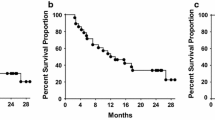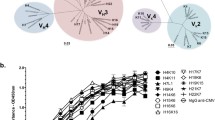Abstract
The CO17-1A/GA733 antigen (Ag), bound by monoclonal antibodies (MAb) CO17-1A and GA733 that define two different epitopes on the Ag, has proven a useful target in passive and active immunotherapy of colorectal carcinoma (CRC). Previous studies suggest that the antitumor effects demonstrated in MAb-treated patients may be mediated by idiotypic cascades. In approaches to active immunotherapy against the Ag, polyclonal goat and monoclonal rat anti-idiotypic antibodies (Ab2) directed against MAb CO17-1A or GA733 (Ab1) were administered as alum precipitates to 54 patients with CRC (stage Dukes' B, C, and D). The majority of the patients treated with the various Ab2 preparations developed anti-anti-idiotypic antibodies (Ab3) that specifically bound to the CO17-1A or GA733 epitope and shared idiotopes with the corresponding Ab1. Approximately 30% of the patients tested developed specific cellular immunity, i.e., Ag-specific T-cells mediating delayed-type hypersensitivity (DTH) reaction in vivo or proliferating on stimulation with the Ag in vitro. The humoral and cellular immune responses may underlie the clinical responses observed in some of the treated patients.
Recently, the CO17-1A/GA733 Ag has been molecularly cloned and expressed in baculo-, adeno-, and vaccinia viruses. In preclinical studies, these recombinant Ag preparations elicited specific humoral immunity (cytotoxic antibodies) and cellular immunity (DTH-reactive and proliferative T-cells), similar to the native Ag. Antibody titers elicited in experimental animals by recombinant Ag were significantly higher than those elicited by Ab2, presumably because Ag expresses numerous epitopes, whereas Ab2 mimics a single epitope. Recombinant CO17-1A/GA733 Ag has potential as a vaccine for CRC patients.
Similar content being viewed by others
References
Herlyn, M., Steplewski, Z., Herlyn, D., et al. (1979)Proc. Natl. Acad. Sci. USA 76, 1438–1442.
Herlyn, D., Herlyn, M., Ross, A. H., et al. (1984)J. Immunol. Meth. 73, 157–167.
Ross, A. H., Herlyn, D., Iliopoulos, D., et al. (1986)Biochem. Biophys. Res. Commun. 135, 297–303.
Sears, H. F., Herlyn, D. M., Herlyn, M., et al. (1981)J. Surg. Res. 31, 145–150.
Sears, H. F., Herlyn, D. M., Herlyn, M., et al. (1982)Cancer 49, 1231–1235.
Mach, J.-P., Chatal, J.-F., Lumbroso, J.-D., et al. (1983)Cancer Res. 43, 5593–5600.
Powe, J., Herlyn, D., Alavi, A., et al. (1985) Radioimmunodetection of human tumor xenografts by monoclonal antibodies correlates with antibody density and affinity, inImmunoscintigraphy. (Button, K. and Donato, L., eds.), Gordon and Breach Science Publishers, New York, pp. 135–152.
Ross, A. H., Herlyn, D., Steplewski, Z., et al. (1989) Monoclonal antibodies as applied to tumor-associated antigens: the CO 17-1A antigen, inHuman Immunogenetics: Basic Principles and Clinical Relevance. (Litwin, S. D., ed.), Dekker, New York, Basel, pp. 107–122.
Frodin, J.-E., Harmenberg, U., Biberfeld, P., et al. (1988)Hybridoma 7, 309–321.
Mellstedt, H., Masucci, G., Rahnhammer, P., et al. (1991)Med. Oncol. Tumor Pharmacother. 8, 207–220.
Herlyn, D., Ross, A. H., and Koprowski, H. (1986)Science 232, 100–102.
Herlyn, D., Ross, A. H., Iliopoulos, D., et al. (1987)Eur. J. Immunol. 17, 1649–1652.
Herlyn, D. and Koprowski, H. (1990) Anti-idiotypes in cancer patients, inCellular Immunity and the Immunotherapy of Cancer. (Lotze, M. T. and Finn, O. J., eds.), UCLA Symposia on Molecular and Cellular Biology, New Series, Wiley-Liss, New York, pp. 421–428.
Herlyn, D., Wettendorff, M., Schmoll, E., et al. (1987)Proc. Natl. Acad. Sci. USA 84, 8055–8059.
Herlyn, D., Benden, A., Kane, M., et al. (1991)In Vivo 5, 615–624.
Herlyn, D., Harris, D., Zaloudik, J., et al. (1994)J. Immunother. 15, 303–311.
Somasundaram, R., Zalouik, J., Jacob, L., et al. (1994) Induction of T- and B-cell immunity in colon carcinoma patients by anti-idiotypic antibody, submitted.
Livingston, P. O., Natoli, E. J., Calves, M. J., et al. (1987)Proc. Natl. Acad. Sci. USA 84, 2911–2915.
O'Boyle, K., Cohen, A., Kemeny, N., et al. (1990)Proc. Annu. Meet. Am. Soc. Clin. Oncol. 9, A494.
Livingston, P. O., Koganty, R., Mackie, E., et al. (1991)Proc. Annu. Meet. Am. Assoc. Cancer Res. 32, A1497.
Bystryn, J.-C., Jacobson, S., Harris, M., et al. (1986)J. Biol. Response Mod. 5, 211–224.
Szala, S., Froehlich, M., Scollon, M., et al. (1990)Proc. Natl. Acad. Sci. USA 87, 3542–3546.
Strassburg, C. P., Kasai, Y., Seng, B. A., et al. (1992)Cancer Res. 52, 815–821.
Zaloudik, J., Linnenbach, A., Acres, B., et al. (1992)FASEB J. 6, A1720.
Herlyn, D., Zaloudik, J., Acres, B., et al. (1992)AACR Proc. 33, 332.
Loibner, H., Plot, R., Rot, A., et al. (1990)The Lancet 335, 171.
Samonigg, H., Wilders-Truschnig, M., Loibner, H., et al. (1992)Clin. Immunol. Immunopathol. 65, 271–277.
Hirshaut, Y. and Slovin, F. (1985)Cancer 56, 1366–1373.
Saeki, Y., Chen, J.-J., Shi, L., et al. (1989)J. Immunol. 142, 2629–2634.
Gottlinger, H. G., Funke, I., Johnson, J. P., et al. (1986)Int. J. Cancer 38, 47–53.
Mittelman A., Chen, Z. J., Yang, H., et al. (1992)Proc. Natl. Acad. Sci. USA 89, 466–470.
Robbins, A. R., Denton, G. W. L., Hardcastle, J. D., et al. (1991)Cancer Res. 51, 5425–5429.
Hamby, C. V., Liao, S.-K., Kanamaru, T., et al. (1987)Cancer Res. 47, 5284–5289.
Author information
Authors and Affiliations
Rights and permissions
About this article
Cite this article
Herlyn, D., Somasundaram, R., Zaloudik, J. et al. Anti-idotype and recombinant antigen in immunotherapy of colorectal cancer. Cell Biophysics 24, 143–153 (1994). https://doi.org/10.1007/BF02789225
Issue Date:
DOI: https://doi.org/10.1007/BF02789225




